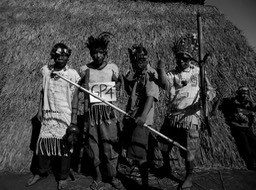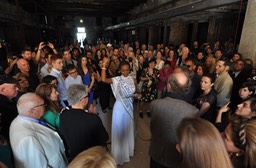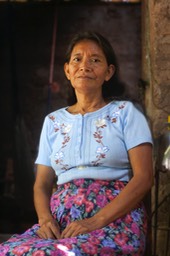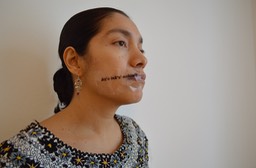At Venice Biennale, Latin America pavilion highlights endangered languages
BY GEORGE FISHMAN
By its nature, the Venice Biennale is a locus for confrontation and disjunction. Adopting an ancient and precarious floating city to temporarily house contemporary art invites both sublime pairings (a glimmering new mesh portrait head by Jaume Plensa in the nave of the renaissance San Giorgio Maggiore church) and awkward dissonances (the bull-in-a-china-shop cruise ships).
These serendipities and clashes contribute to the powerful allure of the Biennale, where interest in this 56th edition was heightened by the appointment of Nigerian-born Okwui Enwezor as chief curator.
The Biennale’s title, “All the World’s Futures,” conveys a pervasive socio-political slant. In his published curatorial statement, Enwezor referenced the two World Wars and wrote, “The global landscape again lies shattered and in disarray, scarred by violent turmoil, panicked by specters of economic crisis and viral pandemonium, secessionist politics and a humanitarian catastrophe on the high seas. …” Not a pretty picture, but one that’s echoed by many — though certainly not all — of the diverse exhibitions from 52 countries that constitute this “world’s fair” of contemporary art. In his videotaped press conference, Enwezor also highlighted the notion of words — sculpted, painted, written or uttered — as a leitmotif that is expressed throughout the many venues.
The Latin American Pavilion, organized by the Italo-Latin American Institute (IILA), integrates the political cast of the Biennale with IILA’s mission to promote challenging artistic dialogs. The organization has a 40-year history at the Biennale and working relationships with 21 member countries. Led by Alfons Hug, the German-born curator and director of the Goethe-Institute in Rio de Janeiro, the curatorial team presents a spare and provocative installation — very different from Hug’s more tumultuous 2013 exhibition in the same space. The work, Indigenous Voices, dramatizes the perilous state of Amerindian cultures in 16 Central and South American countries through their endangered languages.
Alongside physical artifacts and organized activity (whether religious sacrament, military march or tennis match), language serves as a primary carrier of any people’s culture. And when that language is not a written one, the spoken word bears a heightened burden and vulnerability. Consider that of the 600 Amerindian languages spoken in Latin America, about one third are threatened with extinction. In his curatorial statement, Hug says, “With every extinct language not only disappears a valuable linguistic heritage, but also a genuine perspective of the world and environment.” This installation gives voice — literally — to that concern.
THE EXPERIENCE
After traversing a string of ancient massive factory-like buildings that make up the Arsenale portion of the Biennale, visitors enter a final somber, rough-hewn structure resembling a centuries-old barn or warehouse. While eyes adjust to the relative darkness, a cacophony of voices emerges from two rows of loudspeakers flanking a central walkway. Some are high-pitched and chirping, others staccato or singsong, murmuring, gruff or playful. Each tripod-mounted speaker sits several yards from its nearest neighbor, enabling the approaching visitor to distinguish unique features in each oral presentation. But the languages mostly remain unidentifiable by sound alone, as they are not the familiar colonial languages of Central and South America: English, Spanish, French, Portuguese.
The aural experience can be a puzzling or even disorienting. It’s rather like wandering through a cocktail party where everyone is speaking an unfamiliar language. Of course, reality is exactly the opposite: The “foreign” language speakers are those marginalized, and the first-world visitors are principally responsible for their plight.
To create this project, commissioned by IILA’s cultural secretary, Silvia Irrazábal, the curatorial team selected 23 artists of diverse backgrounds and studio practices to compile audio selections from “informants” of their choosing. Each artist had expressed an affinity for the indigenous linguistic heritage of his or her respective country. Some went into the forest, mountaintop or riverside to record. Others chose audio from decades-old investigations by earlier artists and anthropologists. Others recorded their own voices. The artists also selected the subject and the genre — whether fiction, fable, prayer or scientific work.
A small plaque is attached to each loudspeaker stanchion, identifying the artist, language, informant, geography and state of language endangerment. After about 90 seconds, adult and children’s voices unite in a brief, repeated choral song. The audio track, one learns, is from a theatrical work that was presented in Nicaragua and includes myths, children’s games and poetry, along with discussion of problems stemming from transnational logging and fishing. In this work by Nicaraguan Raúl Quintanilla, as in other works here, post-Colonial issues are ever-present.
Such layers of meaning and backstories are not apparent from listening alone — but neither are the cultural references to many visual works obvious to first-time viewer from other locales. The processing of encounters with the unfamiliar is central to the Indigenous Voicesexperience. The producers have intentionally downplayed the graphic and textual elements within the exhibition space. As Hug explains in his curatorial statement, “The radical reduction of the installation to sound only demands intense concentration on the part of the visitors. The more the listeners are willing to immerse themselves in the cosmos of rare languages, the more visual elements can be dispensed with.”
Works reveal artist, subject
Like an exhibition of portraits, the Indigenous Voices installation reveals qualities of both the artists and their subjects.
Guatemalan Sandra Montrosso wrote and narrated her poem, Wind (Roke’b Iq’) in Mayan Q’eqchi’. It conveys a troubled origin myth, and she performs it with echoes, whistling and other dramatic sound effects. In an email, she explained that the work follows “the same structure as Mayan literature was written, trying to develop the use of the metaphor that is an inner characteristic of the Mayan language itself.”
Her photo self-portrait, included in the catalog, shows a text taped to her face, Aa’o ink’a’ nokoxik (We don’t leave). “I did it in response to evictions of Mayan women and men who are reluctant to leave their territory on which companies want to build dams, mining and the extraction of natural resources.” The work is also a tribute to her Mayan Q’eqchi’ grandmother.
We hear Brazilian artist Paulo Nazareth playfully engaging with children of the ethnic group Guariani-Kaiowá as they attempt to mimic each other’s recitation of phrases in the Kaiwá language and Portuguese. The kids also mug for the camera in poses that echo the popular Brazilian rap group Bro MC. This light-hearted expression contrasts with the artist’s catalog entry, in which he uses an autobiographical stream-of-consciousness narrative to dramatize the depredations of cattlemen and mercenaries upon the indigenous peoples driven from native lands. Miami audiences may remember Nazareth from Art Basel Miami Beach 2011, where he sold signed bananas out of an old VW van to evoke “banana republics” and the idiosyncratic art market.
BRAZILIAN ARTIST PAULO NAZARETH DRAMATIZES THE DEPREDATIONS OF MERCENARIES UPON INDIGENOUS PEOPLES DRIVEN FROM NATIVE LANDS. MIAMI AUDIENCES MAY REMEMBER HIM FROM ART BASEL MIAMI BEACH 2011, WHERE HE SOLD SIGNED BANANAS FROM A VW BUS IN A REFERENCE TO BANANA REPUBLICS.
Like The Rape of Venice, a powerful multimedia satellite installation by Andrea Morucchio that pushes back against tourism’s degradation of Venice’s delicate but sustainable urban culture, Indigenous Voices dramatizes the peril of marginalized languages and highlights the harmonious co-existence modeled by tribal communities within their natural surroundings.
Indigenous Voices will travel to 12 South American cities and recently opened in Singapore, where Hug has a seven-month appointment at the Goethe Institute. As a DVD, the sound works will enter various public art collections, including the Humboldt Forum, an art and ethnology museum currently under construction in Berlin.
While the endangerment of indigenous cultures underlies the installation, Hug asserted in an email conversation, “I strongly believe that aesthetic values in art are superior to social and political ones ... . While it certainly may be seen as a preservation effort, personally I feel the most important feature is the richness and linguistic diversity of the indigenous languages in Latin America.”
However, many of the selected participants champion the political both in the work they produced for this audio installation and in their general practices. Bolivian linguist Prof. José Laura Yapita develops multilingual software and introduces scientific research on climate change to indigenous people in his native country. His audio narrative in Aymara — one of the country’s 30 official languages — deals with challenges by agribusinesses to Andean farmers. He offers various low-impact solutions, including small-scale greenhouses. Artistic collaborator Sonia Falcone supplements the audio presentation with photographs of Mayan temple sites, shown online and in the catalog.
Panamanian Humberto Vélez mixes humor, sex appeal and bewilderment in staging a beauty contest coronation, Miss Education 2014, for the opening. In her speech, Yomatzy Hazlewood, who is of mixed African and indigenous Panamanian heritage, spoke in defense of native languages. In this and other performance events, such as a beauty contest for llamas at the Cuenca Art Museum, Vélez questions the hierarchies and standards of “high” and “popular” culture and arbitrary criteria of beauty.
WE STILL DON'T KNOW IF OUR LANGUAGE WILL MANAGE TO SURVIVE… BUT AS LONG AS WE ARE ALIVE, OUR LANGUAGE WILL LIVE TOO.
WERNER HERNÁNDEZ
Mauricio Kabistán’s practice explores El Salvador’s national history, focusing on its civil war (1979-1992) and antecedents. In 1932, tens of thousands of peasants were massacred for their attempted rebellion against president General Hernández Martinez. Kabistán’s informant, Dr. Werner Hernández, relates that indigenous languages were suppressed on pain of death, and many villagers subsequently moved to the city. In a Facebook exchange, Kabistán explained that Dr. Hernández has helped create the Tzunhejekat Collective, which is dedicated to “rescue the Nawat language and raise the visibility of those who speak it.” In the past decade, he noted, the status of indigenous people has improved; a Constitutional amendment now guarantees their rights. In Nawat, Hernández narrates, “We still don’t know if our language will manage to survive … but there is one thing that we do know. Here, today, as long as we are alive, our language will live too.”
Kabistán’s other audio piece, Wan Keman Tanesi (At Daybreak), is a song-like reading by Nantzin Paula López, also in the Nawat language. Kabistán explained, “The poems and songs that she writes came from her heart and traditional histories from her grandparents and her little town [of] Santo Domingo de Guzman,” where he recorded her.
But perhaps the work that best sums up the exhibit comes from Brazilian artist Adriana Barreto’s 2003 recording of Mecias Sateré, an elderly woman from Amazonia, Brazil. “It has been good to have you here,” Sateré said. “and may you take these words in Sateré-Maué with you to your Brazilian companions and out into the world, so that they might know that Sateré exists here in [the town of] Barreirinha and that they are the protectors of nature.”
This hopeful sentiment is both rigorously questioned and affirmed on the global stage in Venice.
Listen to audio bitly.com/IndigenousVoices
IF YOU GO
What: ‘Indigenous Voices’
When: Through Nov. 24
Where: Venice Biennale, Pavilion of Latin America-IILA at Arsenale
Information: Phone (+39) 041 5218711; www.labiennale.org; aav@labiennale.org



